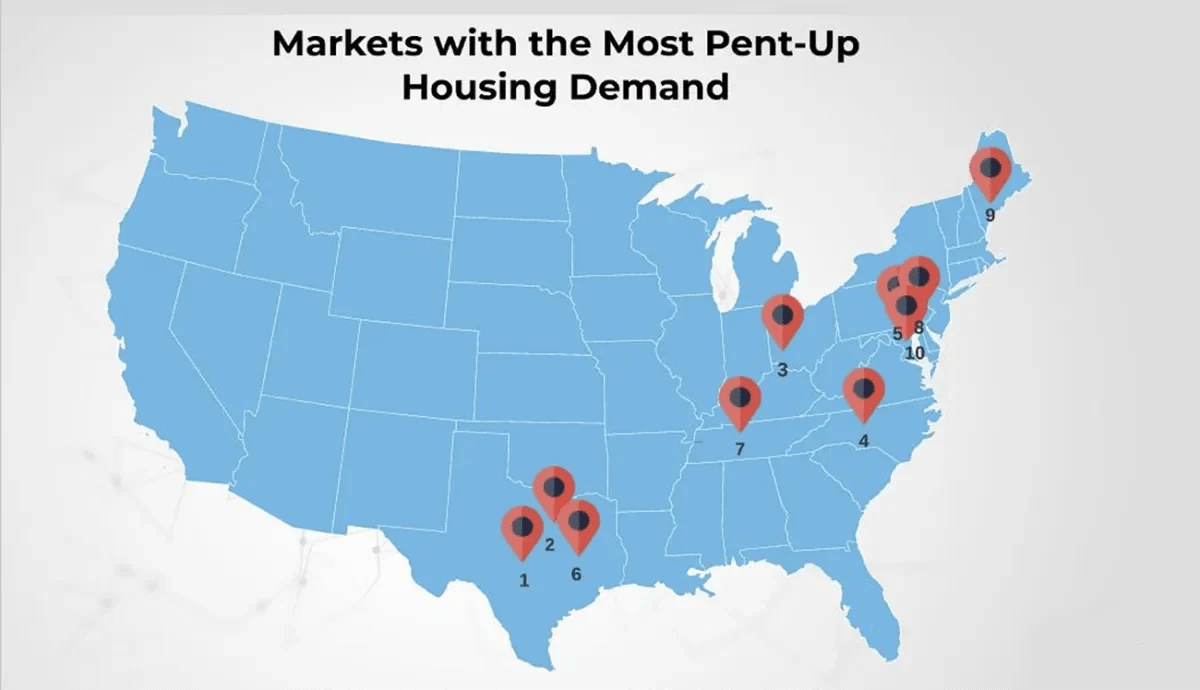|
NAR has identified the following metros with the most pent-up housing demand. This statistic is based on how local markets compare to the national level using 10 crucial economic indicators, such as the number of affordable listings and potential sellers, job growth, and income growth. |
|
Here’s their list: |
|
After a year marked by a market slowdown, anticipation was high that 2023 would usher in a turning point for both the economy and the housing market. Nevertheless, despite a cooling inflationary environment, the economy faced additional challenges as the Federal Reserve implemented multiple interest-rate hikes throughout 2023. These rate increases - amounting to a cumulative one percentage point – exerted further pressure on every kind of borrowing.
Consequently, mortgage rates surpassed the 7.5 percent threshold for the first time after 23 years, pushing housing affordability to record lows.
With many buyers forced out of the market, the housing market continued its second consecutive year of slowdown in 2023. Although housing inventory is above the 1.1 million homes available for sale in 2023, data shows that these additional homes weren't enough to accommodate housing demand, albeit lower than the previous year.
But this isn't a new issue. The current housing shortfall has been accumulating over decades. After the mid-2000s housing boom, the U.S. has consistently underbuilt compared to the historical average. Furthermore, with mortgage rates hovering around 7 percent for most of the year, fewer homeowners opted to list their homes in 2023. Consequently, this long-standing underbuilding issue and the rate lock-in effect kept housing inventory low throughout the year.
Following two years of subdued activity, the housing market is expected to grow in 2024. Several signs point to an imminent market recovery.
Since all real estate is local, the National Association of REALTORS® identified which markets will experience stronger activity in the new year. In identifying these markets, NAR considered a variety of indicators that it views to be influential to a metro area's market in this report.
More "returning" buyers than at the national level
Lower mortgage rates will improve housing affordability, enticing a greater number of buyers back into the market in 2024. The influx of these "returning" buyers is expected to stimulate activity in the housing market. NAR calculated and compared the number of households able to afford the median-priced home at 7.5% versus a 6.5% mortgage rate across the 100 largest metro areas. Then, the share of "returning" buyers was computed by comparing these "returning" buyers with the total number of households in each metro area. A share of "returning" buyers exceeding the national level indicates stronger market activity. Hence, areas with a share of "returning" buyers higher than the national level are expected to outperform.
Home price appreciation lower than the national level
NAR computed the home price growth for the 100 largest metro areas to identify those most affected by slower activity in 2023. While these areas appear to be more susceptible to market changes, they will likely also undergo significant price appreciation due to the pent-up demand in 2024.
More renters who can afford to buy the median-priced home than the national level
Homeownership rate trends depend on the ability of renters to become homeowners. Among all renters, NAR computed how many of them can afford to buy the typical home, assuming a 10% down payment. Areas with a higher share of renters who can afford to buy the median-priced home compared to nationwide indicate higher home-buying activity in those areas.
More potential sellers than the national level
In anticipation of lower mortgage rates, many existing homeowners didn't list their homes in 2023, reluctant to give up their 3% rate. But, with lower mortgage rates, these pent- up sellers are expected to boost activity in the market in 2024. NAR computed the number of homeowners staying in their homes for a duration equal to or exceeding the average tenure within each metro area, aiming to identify potential sellers. Thus, areas with most homeowners who have surpassed the average tenure are more likely to experience stronger activity with slowing mortgage rates in 2024.
A larger decrease in remote workers than at the national level
The surge of remote work has increased the demand for housing and altered preferences for housing locations. Respectively, as an increasing number of companies shift away from telework, a drop in remote work is also expected to increase demand as people need to be back to their offices. Areas with a larger drop of remote workers than the national level may experience stronger housing demand.
More affordable listings for first-time buyers than at the national level
After computing the maximum price of housing that first-time buyers can afford, NAR identified the areas with the most affordable listings. Areas with more affordable listings for first- time buyers than the national level are expected to outperform
Stronger job growth than the national level
A robust job market typically bolsters housing demand as household incomes continue to grow. Thus, areas with stronger job growth than the national level typically experience higher homebuying activity than other areas.
Faster income growth than the national level
Rising incomes enable people to afford to purchase a home, increasing housing demand. Thus, housing demand is expected to be stronger in areas where people's income rises faster than the national level. Most high-earner millennial renters moving into the area While first-time buyers make up one in three sales, the arrival of high-earner renters from other states is poised to boost housing activity in the area.
Lower violent crime rate than the national level
Research has shown that people purchase homes in areas that provide a secure and stable environment for their families. Thus, areas with a low violent crime rate are considered more attractive to buyers.






